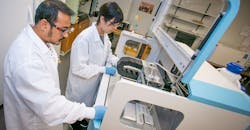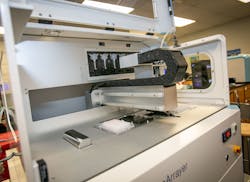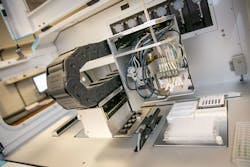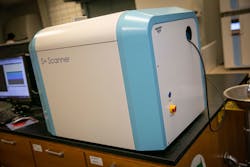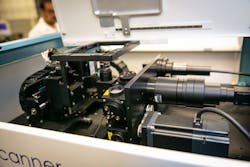3D Printing Revolution Leads to Human Evolution
Recently, Stephen Hong and Moo-Yeal Lee from the Department of Chemical & Biomedical Engineering at Cleveland State University, published a paper on their efforts to 3D print human tissue replicas. The following is taken both from their full paper and “A Look at the Future of Medical 3D Printing, Part 2.”
Bioprinting is surrounded by a lot of hype, as many see it offering a way to replace cells and tissue for a longer and healthier life. Could the fountain of youth be extruded or extracted primordial goo from a 3D printer?
Two CSU students operate a microsolenoid-based bioprinter. The machine allows scientists to print human cells in hydrogels, allowing for the creation of human tissue replicas.
Reality
Before we get caught up in immortality, let’s try to focus on our current reality. According to the NLM report: “In 2009, 154,324 patients in the U.S. were waiting for an organ. Only 27,996 of them (18%) received an organ transplant, and 8,863 (25 per day) died while on the waiting list. As of early 2014, approximately 120,000 people in the U.S. were awaiting an organ transplant. Organ transplant surgery and follow-up is also expensive, costing more than $300 billion in 2012.
“An additional problem is that organ transplantation involves the often difficult task of finding a donor who is a tissue match,” the report continued. “This problem could likely be eliminated by using cells taken from the organ transplant patient’s own body to build a replacement organ. This would minimize the risk of tissue rejection, as well as the need to take lifelong immunosuppressants.”
A microsolenoid-based bioprinter allows scientists to print biological samples including human cells, viruses, hydrogels, compounds, and reagents in high throughput. This allows for higher quality and more efficient toxicity and drug testing.
Technology
At present, we are at least 20 years from seeing lifesaving complex printed organs. However, researchers are currently working on printing miniature organs. The problem is one of scaling. The diffusion of oxygen from the host vasculature will nourish the transplanted tissue (often vascular, lymphatic, or nerve cells). Unfortunately, once the engineered tissue exceeds 150-200 micrometers, it no longer supports the oxygen diffusion needed between host and transplanted tissue. This mean to get a complex organ, scientists will need to find a way to scale up with an advanced multicellular structure with the vascular network integrated into the part.
A sample dispensing head with six microsolenoid valves and inspection cameras. Biological samples can be loaded on to the 96-well plate and then printed onto a 384PillarPlate for easy analysis.
Bioinks
Hong and Lee’s paper talked a lot about the bioinks that are making it possible to print living cells. Bioinks are a mixture of human cells, hydrogels, growth factors, and extracellular matrices (ECMs). These bioinks can then be 3D printed as disease models for predictive drug screening. There has been an explosion in interest for 3D-printed human tissues; from an estimated $295 million in 2016, its global market size is expected to grow to $1.8 billion by 2021, according to BCC Research. These values are based on the applications of 3D-printed tissues, which include disease tissue modeling, toxicology testing, tissue engineering, and skin transplants.
For example, tumor cells extracted from biopsy samples can be printed and matured in the laboratory to create patient-specific tumor replicas, which can then be used to screen combinations of therapeutic drugs to create individualized cancer treatments. Although there are still several technical challenges, there is a bright future for 3D bioprinting technology.
Although the process of 3D bioprinting is fairly simple, various numbers of available bioinks, bioprinters, cell culture/maturation and staining protocols, and cell imagers make it difficult to choose which specific component is best suited for a specific need. By examining each specific component, this provides greater insight into how 3D bioprinting can be best utilized.
The way bioinks cure, or polymerization, can vary between different hydrogels. The most common are:
- Photopolymerization
- Ionic polymerization
- Temperature-responsive polymerization
Depending on which process is selected, curing additives (a.k.a., crosslinkers) are needed, but could be potentially toxic to the cells within the bioinks. This can be resolved by using gentler polymerization processes, but this generally leads to longer polymerization times or weaker gel structures. Therefore, sacrificial and support bioinks can be used to provide temporary or permanent support until the hydrogel can fully cure.
An automated fluorescent microscope for taking images of cells rapidly from a 384PillarPlate sample.
Clinical Applications of Bioprinted Tissues
While we aren’t able to print full-scale complex organs, printing models can help streamline drug testing and create custom drugs for an individual. While powder binders can create custom dosages and precision time release, bioprinting can use an accurate model of the patent to test how it will affect patients before testing it on a person. Furthermore, the ability to print accurate human replicas helps eliminate drug testing on animals, thus avoiding ethical and accuracy concerns.
An automated fluorescent microscope with four filter channels and a CCD-based detector for high-throughput image acquisition.
Drugs in CAD
While software is important to take the data from a patient to make a model, CAD simulations are streamlining the process and helping to reduce FDA approval times. The FDA will often approve a specific drug for a specific dose. This means custom dosing may take longer to approve than is effective for the patient. However, Dassault Systemes showed off its CAD software’s ability to create digital patients.
Using data from real patients, chemistry, and an understanding the human body, a group of digital patients can prove to be more accurate than animal testing. In addition to the aforementioned ethical and accuracy concerns, this eliminates much of the time associated with FDA approval to start clinical trials. Between software technology and accurate bioink models, custom dosing might be able to streamline FDA approval for patients to receive just the right dose they need with the safety and quality the FDA demands.
For example, bioprinting and bioinks can use a tumor cells extracted from biopsy samples to print and mature in the laboratory to create patient-specific tumor replicas. Then the replica can screen combinations of therapeutic drugs to create individualized cancer treatments. With the extremely low success rate of the current gene-targeted cancer therapy, the 3D bioprinting approach could be a good alternative.
An injection-molded 384PillarPlate loaded on a bioprinter for layered cell printing and culture.
Estimated Market Size of Bioprinted Tissues
While complex organs are still working on scaling to create prefect matches to eliminate the organ transplant list and tissue rejection, bioprinting is still find ways into the medical industry. Models for drug screening are just one of the ways 3D bioprinting will change our lives.
As the technology begins to develop, the interest in 3D bioprinting only continues to grow. The expected explosion in market value mentioned earlier is due to the clinical applications that will become available by 2021. In addition to oncology, the cardiovascular, orthopedic, and plastic surgery fields will greatly benefit from 3D bioprinting as its ability to print tissue grafts provide greater medical advantages compared to traditional methods. Although the applied and research markets will not reach the same valuation as the clinical industry, they are still expected to more than double in the next five years.
3D bioprinting is still in a relatively fledging state, but its impact for research and clinical applications are paramount. It has already shown to be more accurate and representative of in vivo tissue cultures and aims to be tenable to current high-throughput screening methods. Challenges in this field only serve to be opportunities to expand. We are still far from printing a beating heart, but it is not outside the realm of possibility.
